Exploring the Marvels of the Renaissance Architecture
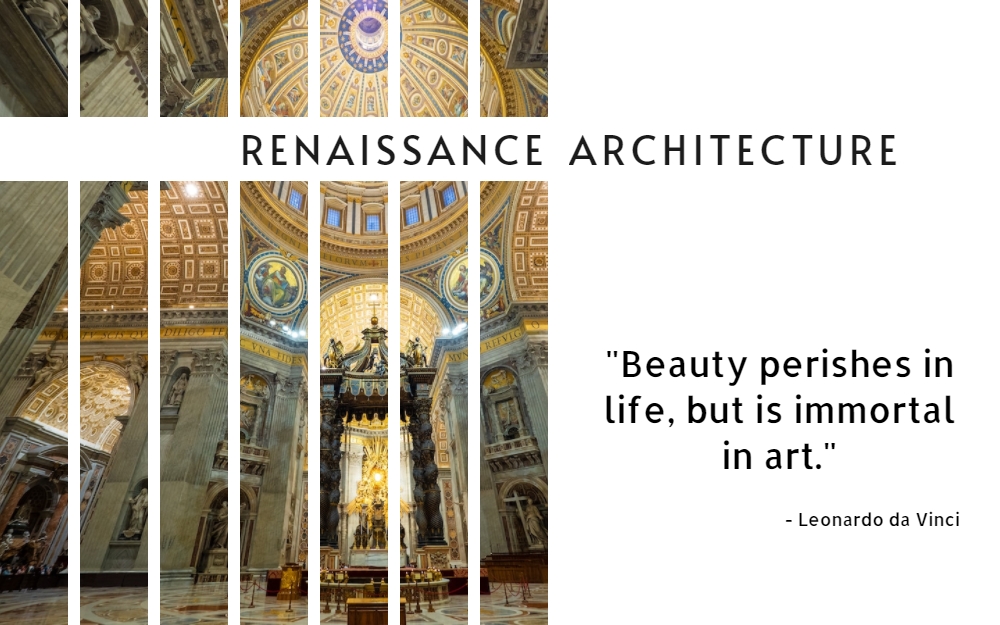
Renaissance architecture, originating in 15th-century Italy, stands as a pivotal movement that redefined artistic and architectural expression after the medieval period. It embraced a profound shift from the dark and cloistered aesthetics of the past to a celebration of humanism, innovation, and classical ideals. Characterized by symmetry, proportion, and harmony, Renaissance architecture exudes a profound connection to the principles of ancient Greek and Roman design.
A hallmark of Renaissance architecture is its revival of classical elements such as columns, arches, and domes, reflecting a desire to recapture the elegance and grandeur of antiquity. The innovative use of perspective and mathematical precision led to the creation of awe-inspiring spaces and structures that resonated with human proportions, instilling a sense of balance and beauty.
Prominent architects like Filippo Brunelleschi and Leon Battista Alberti championed the concept of the “perfect building,” emphasizing geometry and the golden ratio. This era also witnessed the birth of the domed cathedral, epitomized by Brunelleschi’s groundbreaking work on Florence’s Santa Maria del Fiore, showcasing technical prowess alongside artistic vision.
The Renaissance architectural style wasn’t confined to Italy; it spread across Europe and adapted to regional nuances while preserving its core principles. The Louvre in Paris, inspired by Renaissance aesthetics, demonstrates the style’s reach beyond Italy’s borders.
Renaissance architecture’s legacy endures in modern times. Its emphasis on proportion, perspective, and the marriage of beauty and function continues to influence architectural discourse. This style laid the foundation for the subsequent evolution of architectural expression, bridging the gap between the past and the future with its harmonious blend of classical wisdom and innovative spirit.
Notable Hallmarks of Renaissance Architecture Style
Certainly, here are some notable buildings designed in the Renaissance architectural style:
- Florence Cathedral (Santa Maria del Fiore) – Florence, Italy
- St. Peter’s Basilica – Vatican City
- Palazzo Vecchio – Florence, Italy
- Palazzo Medici Riccardi – Florence, Italy
- The Uffizi Gallery – Florence, Italy
- Santo Spirito Basilica – Florence, Italy
- Palazzo Pitti – Florence, Italy
- Palazzo Farnese – Rome, Italy
- Piazza del Campidoglio – Rome, Italy
- Château de Chambord – Loir-et-Cher, France
- Château de Fontainebleau – Fontainebleau, France
- Palace of Charles V – Alhambra, Spain
- Royal Palace of Madrid – Madrid, Spain
- Wawel Castle – Kraków, Poland
- Rosenborg Castle – Copenhagen, Denmark
- Hampton Court Palace – London, England
- St. James’s Palace – London, England
- Palazzo Ducale – Venice, Italy
- Pitti Palace – Florence, Italy
- Palazzo dei Diamanti – Ferrara, Italy
- Palazzo Te – Mantua, Italy
- El Escorial – San Lorenzo de El Escorial, Spain
- Villa Farnese – Caprarola, Italy
- Château de Blois – Blois, France
- Palazzo Chiericati – Vicenza, Italy
These are just a few examples of buildings that showcase the Renaissance architectural style. Each of these structures exemplifies the principles of symmetry, proportion, and a revival of classical elements that are characteristic of Renaissance design. The style’s influence spread across Europe and beyond, leaving an indelible mark on architectural history.
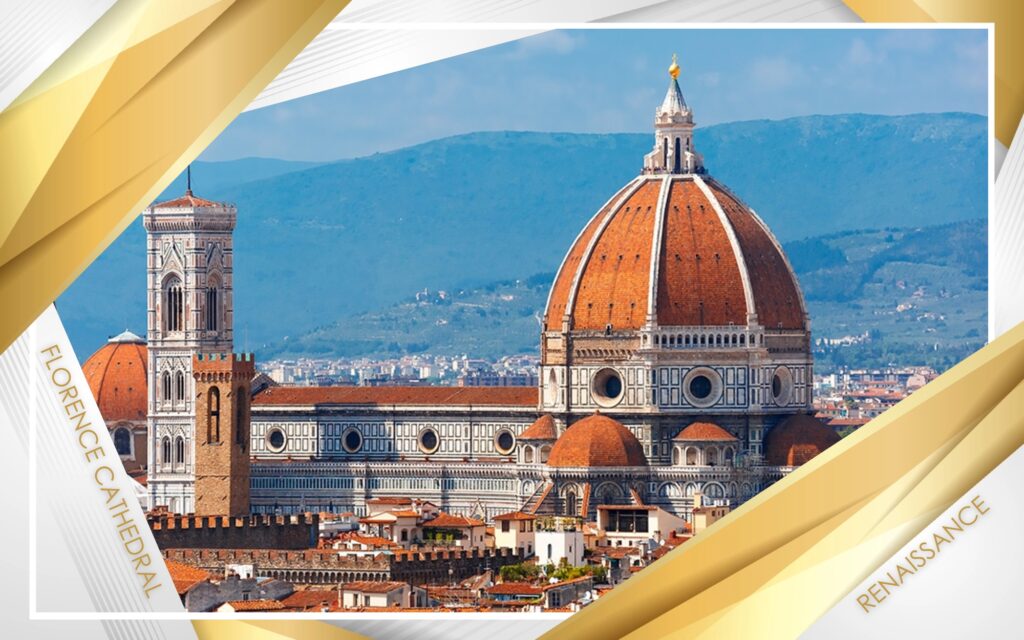
Florence Cathedral (Santa Maria del Fiore)
Florence, Italy
The Florence Cathedral, also known as Santa Maria del Fiore, stands as a crowning jewel of Renaissance architecture and a symbol of Florence’s cultural and artistic heritage. Its architectural design features embody the essence of the Renaissance style and showcase the mastery of its creators.
One of the most remarkable features is the cathedral’s massive dome, designed by Filippo Brunelleschi. This dome, an engineering marvel of its time, utilizes innovative techniques such as a double-shell structure and herringbone brickwork to create a self-supporting and harmoniously proportioned dome that gracefully crowns the cathedral.
The cathedral’s facade exhibits intricate marble panelling and decorative motifs, including the iconic “Gates of Paradise” doors designed by Lorenzo Ghiberti. The use of classical elements such as columns, arches, and pilasters pays homage to the revival of ancient Roman architectural principles.
Inside the cathedral, the vast interior space is characterized by a Latin cross plan with a nave and two side aisles. The nave’s soaring columns and expansive arches create a sense of grandeur and proportion, while the intricate stained glass windows infuse the space with a serene and colourful illumination.
The cathedral’s campanile, known as Giotto’s Campanile, stands adjacent to the main structure and exhibits a similar attention to detail and proportion. Its decorative marble cladding, elegant sculptural reliefs, and Gothic-inspired design contribute to the harmonious ensemble of the cathedral complex.
The architectural design of the Florence Cathedral serves as a testament to the Renaissance ideals of humanism, mathematical precision, and the fusion of aesthetics and engineering prowess. Its enduring influence resonates through the ages, capturing the essence of an era that sought to bridge the gap between the classical past and the future of architectural innovation.
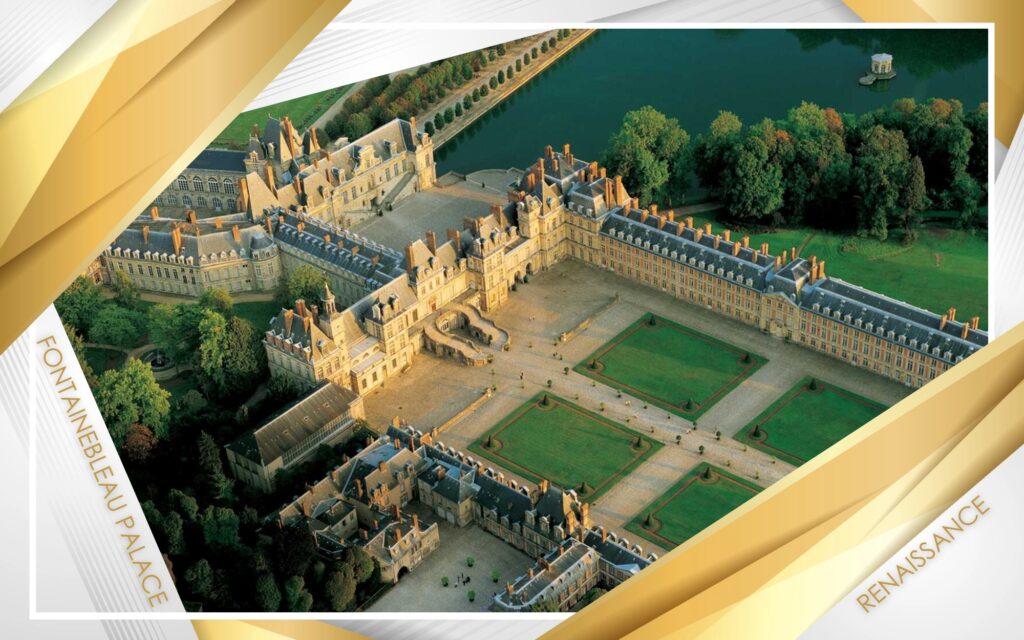
Château de Fontainebleau
Fontainebleau, France
Château de Fontainebleau, situated near Paris, France, is a masterpiece of architectural evolution that reflects centuries of artistic and historical influences. Its design features a captivating blend of Gothic, Renaissance, and later styles, making it a unique and significant landmark in the realm of European architecture.
Originally a medieval hunting lodge, the château underwent numerous expansions and renovations over the centuries. Its architectural features are a testament to the changing tastes and preferences of French royalty and the architects who shaped its identity.
The central block, designed during the Renaissance under the guidance of François I, boasts harmonious symmetry and classical elements. The stunning horseshoe-shaped staircase, known as the “escalier en fer à cheval,” serves as a focal point, showcasing intricate carvings, delicate balustrades, and a majestic sense of ascent.
Fontainebleau’s sprawling courtyards, gardens, and terraces interact seamlessly with the château, providing outdoor spaces that complement the grandeur of its interior. The François I Gallery, adorned with frescoes and ornate stuccowork, captures the opulent spirit of the Renaissance.
Later additions, such as the Louis XIII Wing and the Grand Parterre Garden, represent shifts in architectural sensibilities. The château’s layout and subsequent renovations exhibit a fusion of Gothic elements, Renaissance symmetry, and Baroque exuberance.
The château’s reflection of various architectural styles over time transforms it into a living chronicle of French history and design evolution. Fontainebleau’s ability to harmonize diverse aesthetics within a cohesive whole illustrates the dynamic nature of architectural progression and the enduring impact of each era’s creative vision.
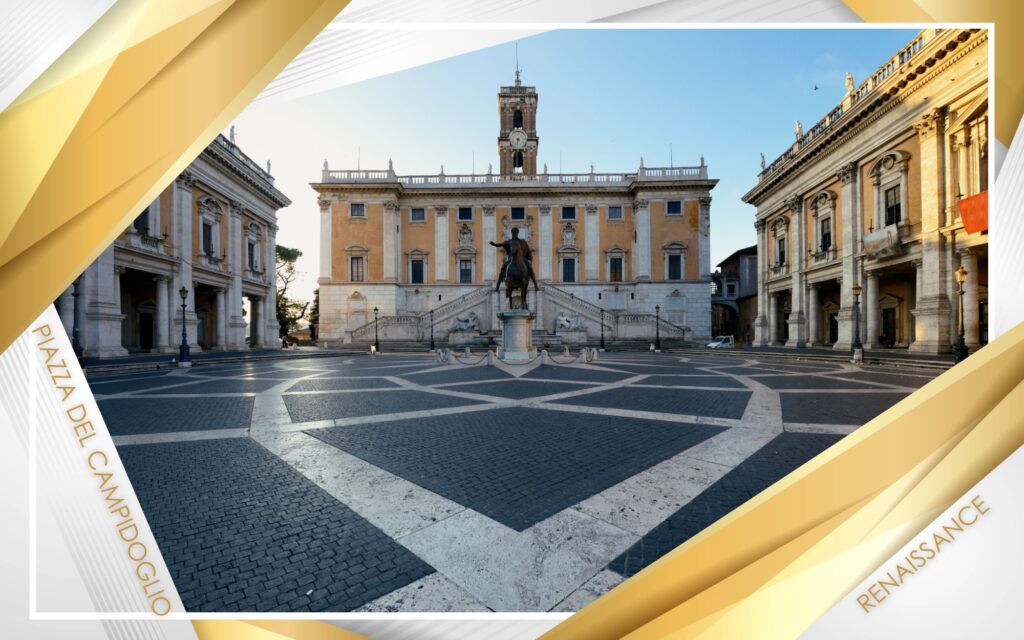
Piazza del Campidoglio
Piazza del Campidoglio, a masterpiece of urban planning and architectural design located in Rome, Italy, epitomizes the Renaissance ideals of harmony, proportion, and classical revival. Designed by Michelangelo Buonarroti, this historic square stands as a testament to his genius and the transformative power of architecture.
The focal point of the piazza is the equestrian statue of Emperor Marcus Aurelius, which stands atop a grand pedestal. The statue pays homage to ancient Roman equestrian sculptures while infusing them with Michelangelo’s nuanced approach to anatomy and expression.
Surrounding the piazza are three palaces: the Palazzo Senatorio, the Palazzo dei Conservatori, and the Palazzo Nuovo. These structures were reconfigured by Michelangelo to align with a trapezoidal design, adapting to the irregular shape of the Capitoline Hill. The harmonious facades feature pilasters, arches, and pediments, all embodying the classical vocabulary of Roman architecture.
The Cordonata, a majestic staircase, provides a monumental approach to the piazza. Its design combines broad steps with a gentle incline, leading visitors to the heart of the square. The geometric paving, known as the “Cento Celle,” exhibits a dynamic pattern that radiates from the centre, creating an illusion of perspective.
The equestrian statue, the monumental palaces, the harmonious layout, and the use of classical elements all contribute to Piazza del Campidoglio’s reputation as an exemplar of Renaissance urban design. It encapsulates the period’s reverence for antiquity while introducing innovative solutions to architectural and spatial challenges. Today, the piazza continues to inspire architects and urban planners, reminding us of the enduring impact of visionary design on our built environment.
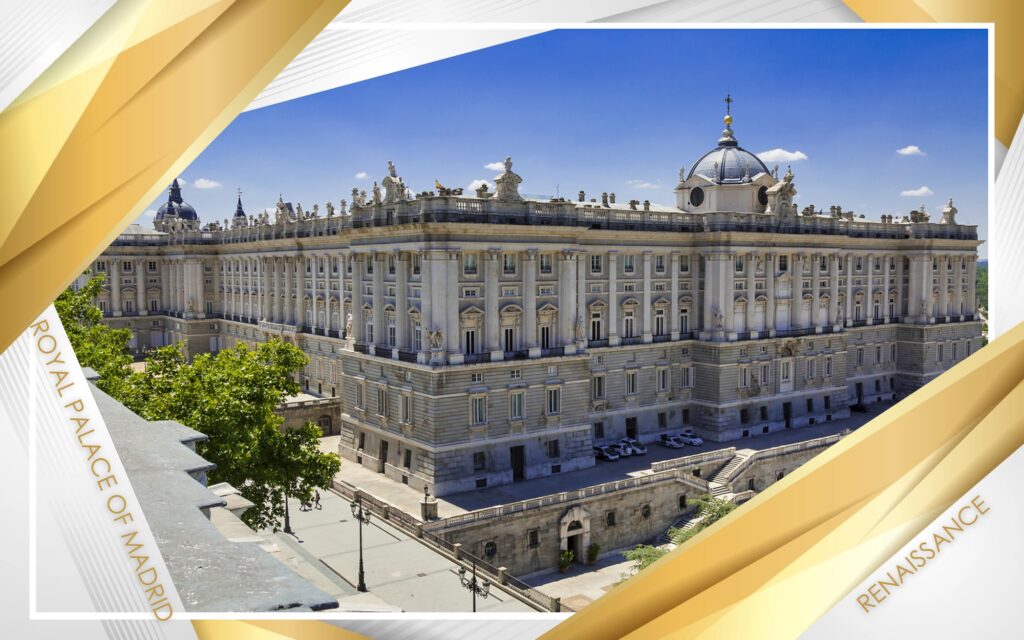
Royal Palace of Madrid
Madrid, Spain
The Royal Palace of Madrid, located in Spain’s capital city, is a magnificent example of European architecture that seamlessly blends Baroque and Neoclassical elements. Serving as the official residence of the Spanish Royal Family, this grand edifice boasts a rich history and a stunning array of architectural features.
The palace’s exterior exudes a commanding presence, characterized by its symmetrical facade adorned with ornate balconies, pilasters, and intricate sculptural decorations. The central section features a monumental balcony with a prominent balcony known as the “Balcony of the King,” where important royal ceremonies and events have taken place.
One of the most remarkable features is the grand staircase, which serves as the palace’s centrepiece. Designed by Italian architect Filippo Juvarra, the staircase showcases a sweeping double ramp that allows for an effortless ascent, flanked by statues and adorned with opulent details.
The Salón del Trono, or Throne Room, is a masterpiece of design with its lavish decorations, including sumptuous tapestries, gilded elements, and intricate frescoes. The Hall of Mirrors, influenced by France’s Palace of Versailles, is another highlight, featuring mirrored walls that create an illusion of space and opulence.
The Royal Palace’s interior rooms reflect various architectural styles, including Rococo and Neoclassicism. The opulent Royal Chapel features a stunning dome and intricate altarpiece, while the Royal Armory showcases an impressive collection of armour and weapons.
The palace’s lush gardens, known as the Sabatini Gardens, provide a serene contrast to the grandeur of the building. With its impressive architectural features, opulent interiors, and historical significance, the Royal Palace of Madrid stands as a testament to the cultural and artistic heritage of Spain and continues to captivate visitors with its breathtaking design.
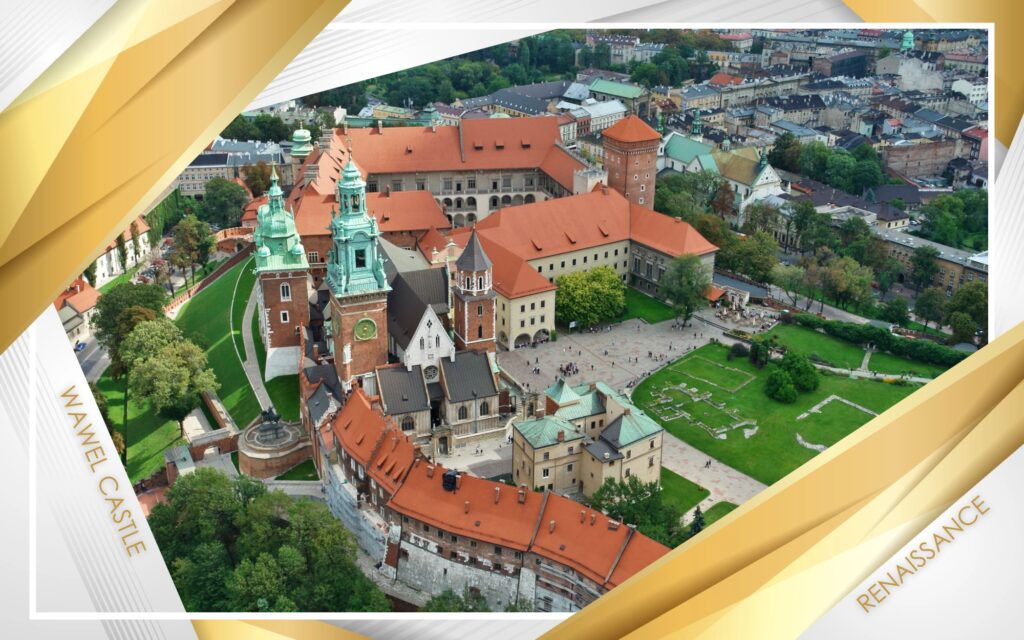
Wawel Castle
Kraków, Poland
Wawel Castle, a majestic hilltop fortress in Kraków, Poland, is a historical and architectural gem that showcases a diverse blend of styles spanning centuries. Its design features have been shaped by various periods, making it a microcosm of Polish history and culture.
The castle’s architectural composition is a fusion of Gothic, Renaissance, and Romanesque elements. Its centrepiece, the Wawel Cathedral, is a prime example of Polish Gothic architecture, characterized by its soaring spires, pointed arches, and intricate ornamentation. The Sigismund Chapel within the cathedral, designed by Bartolomeo Berrecci, is a masterpiece of Renaissance architecture, adorned with exquisite sculptural details and elegant proportions.
The castle’s Royal Apartments, located in the Wawel Royal Castle proper, showcase Renaissance and Baroque influences with ornate woodwork, stucco decorations, and rich tapestries. The grand halls, such as the Senator’s Hall, feature sumptuous ceilings with intricate paintings and gilded elements.
The iconic Wawel Dragon Statue, located at the base of the castle, adds a touch of whimsy to the site. It references a popular Polish legend and has become an integral part of the castle’s identity.
The Wawel Hill complex includes a range of structures, from defensive walls to courtyards, each reflecting the architectural priorities of the time it was built or renovated. The castle’s panoramic views of the Vistula River and the city of Kraków further enhance its appeal.
Wawel Castle’s architectural design features embody the evolution of Poland’s history, combining diverse styles and influences into a harmonious ensemble. Its significance as a cultural symbol, a historical repository, and an architectural marvel makes it a must-visit destination for those interested in the rich tapestry of Polish heritage and architectural evolution.
For more interesting news and facts, check out our website New Facts World and follow us on Instagram.



